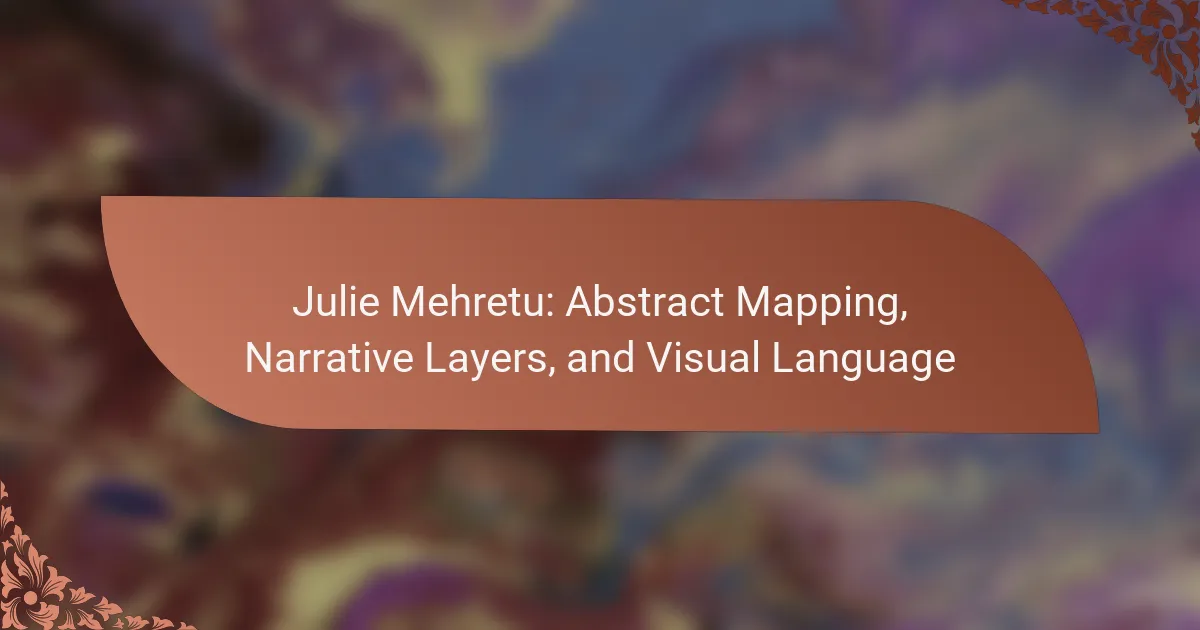Julie Mehretu’s abstract mapping creates a powerful dialogue around contemporary issues such as migration and identity. Her layered narratives and dynamic visual language invite multiple interpretations. This article explores her unique techniques, the significance of narrative layers, and the impact of her work across cultural landscapes. Mehretu’s artistry challenges traditional perspectives, enhancing our understanding of the interplay between chaos and order in society.
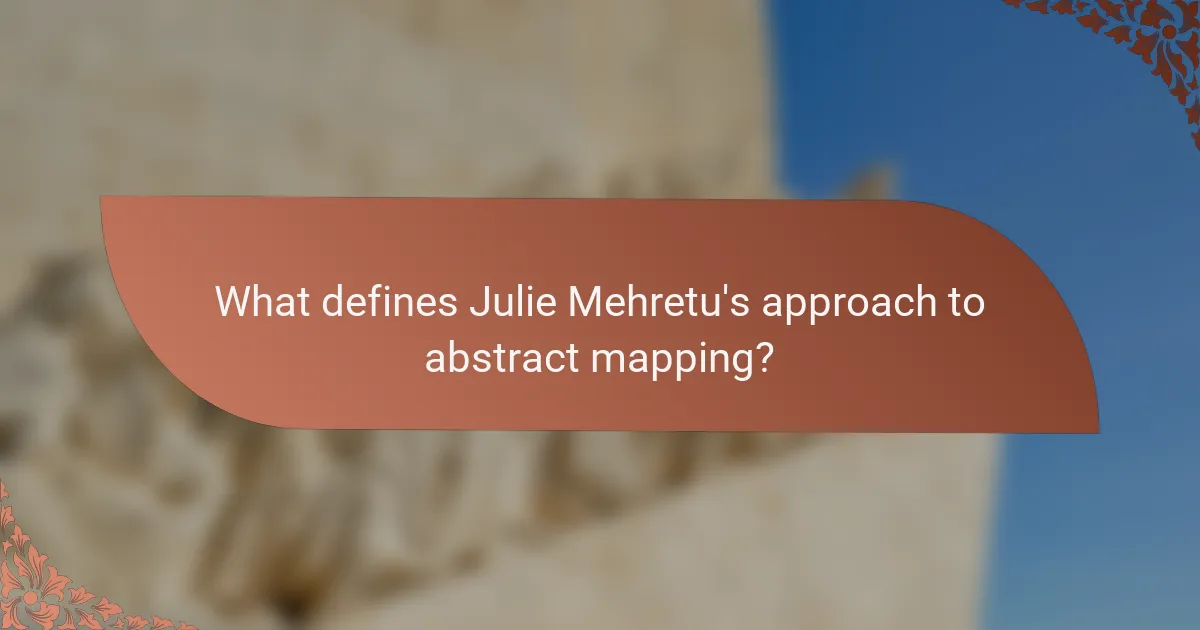
What defines Julie Mehretu’s approach to abstract mapping?
Julie Mehretu’s approach to abstract mapping emphasizes layered narratives and dynamic visual language. Her work intertwines personal, historical, and global contexts, creating complex compositions that challenge traditional mapping. Unique attributes include her use of architectural elements and gestural abstraction, which differentiate her from other contemporary artists. Mehretu’s art often reflects themes of migration, identity, and social dynamics, making her visual language a powerful commentary on contemporary issues.
How does abstract mapping manifest in her artwork?
Julie Mehretu’s artwork manifests abstract mapping through intricate layers that represent narratives and histories. Her use of dynamic lines and forms creates a visual language that conveys movement and change. This approach allows viewers to engage with the complexity of urban environments and social structures. The combination of architectural elements and gestural marks reflects the interconnectedness of personal and collective experiences.
What are the key elements of Mehretu’s visual language?
Julie Mehretu’s visual language is characterized by abstract mapping, narrative layers, and dynamic compositions. Her work integrates multiple elements such as architectural forms, geographic references, and historical narratives, creating a complex interplay of visual information.
Key elements include:
– **Layering**: Mehretu employs layers to create depth and complexity, allowing viewers to engage with multiple narratives simultaneously.
– **Abstraction**: Her use of abstract forms and symbols communicates broader themes of identity, migration, and globalization.
– **Spatial Dynamics**: The compositions reflect movement and change, often resembling maps that chart social and political landscapes.
– **Color and Texture**: Vivid colors and varied textures enhance the emotional impact, inviting interpretation and reflection.
These elements combine to form a unique visual language that challenges traditional representation and engages audiences in a dialogue about contemporary issues.
Which historical influences shape her narrative layers?
Julie Mehretu’s narrative layers are shaped by historical influences such as migration, globalization, and urbanization. Her work reflects the complexities of contemporary society, intertwining personal and collective histories. The layering of abstract forms in her art symbolizes the interwoven narratives of different cultures and experiences. Additionally, the impact of political events and social movements adds depth to her visual language, making her artwork a commentary on the past and present.
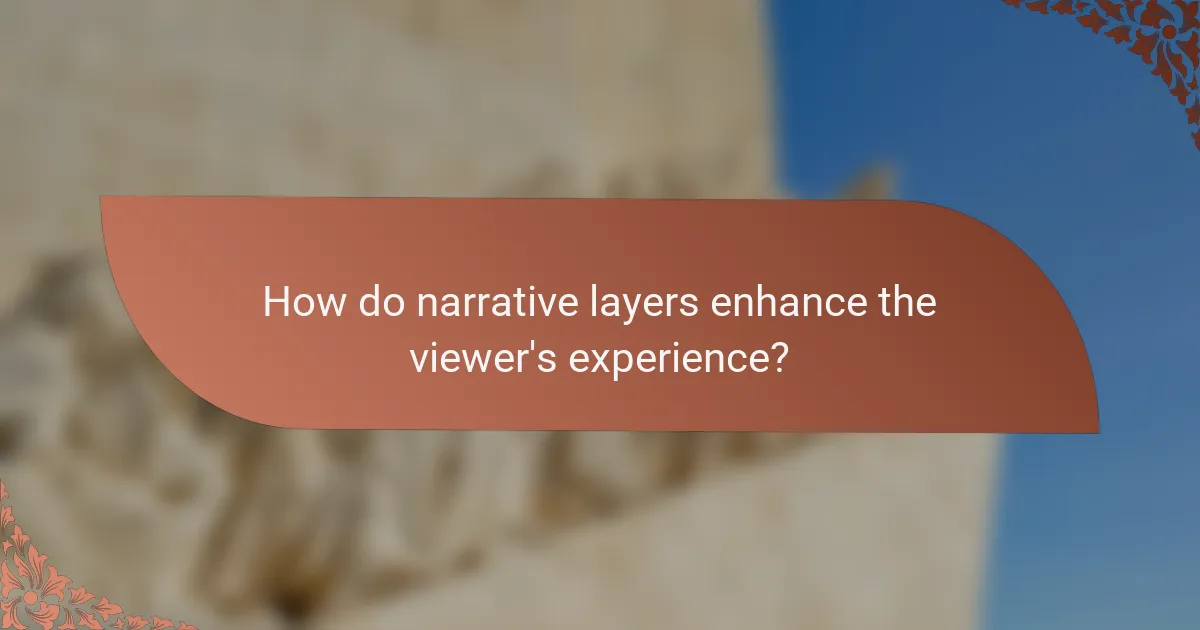
How do narrative layers enhance the viewer’s experience?
Narrative layers enhance the viewer’s experience by adding depth and complexity to visual art. They invite viewers to engage with multiple interpretations and emotional responses. Julie Mehretu’s use of abstract mapping creates a dialogue between personal and collective histories, enriching the narrative. This layered storytelling encourages active participation, allowing viewers to explore their own connections to the artwork.
What techniques does Mehretu use to create depth in her narratives?
Julie Mehretu employs layering techniques, abstraction, and spatial dynamics to create depth in her narratives. Her work integrates multiple perspectives and historical references, allowing viewers to engage with complex themes. The use of mapping and gestural marks enhances the visual language, creating a sense of movement and time. Additionally, her incorporation of architectural elements and urban landscapes contributes to a rich narrative context, inviting interpretation and reflection.
How does the layering process reflect cultural contexts?
The layering process in Julie Mehretu’s work reflects cultural contexts by integrating diverse narratives and histories. Her abstract mapping technique captures the complexity of urban environments, emphasizing how layers of meaning interact within specific cultural frameworks. Each layer serves as a visual language that communicates socio-political themes, illustrating the interconnectedness of personal and collective experiences. This approach allows viewers to engage with the artwork on multiple levels, revealing how cultural contexts shape perception and interpretation.
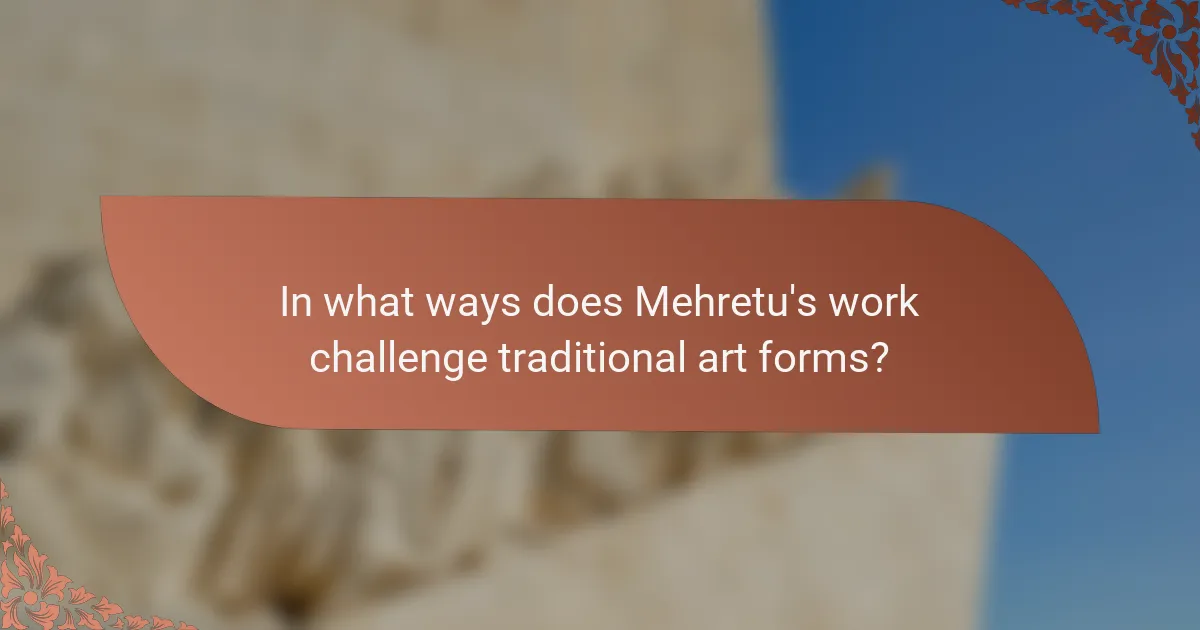
In what ways does Mehretu’s work challenge traditional art forms?
Julie Mehretu’s work challenges traditional art forms by integrating abstract mapping with narrative layers. Her unique approach combines various techniques, such as layering and transparency, to create complex visual languages. These elements disrupt conventional perspectives, inviting viewers to engage with the artwork on multiple levels. Mehretu’s use of diverse materials and cultural references further distinguishes her practice, making her art a commentary on contemporary issues. Her innovative style encourages a reevaluation of the boundaries of abstraction and representation in modern art.
Which modern themes are prevalent in her pieces?
Julie Mehretu’s pieces often feature themes of abstraction, mapping, and layered narratives. Her work explores the intersection of geography and identity, reflecting complex sociopolitical landscapes. Additionally, she incorporates dynamic visual language, emphasizing movement and transformation. These themes invite viewers to engage with the complexities of contemporary life and history.
How does her art engage with contemporary social issues?
Julie Mehretu’s art engages with contemporary social issues by layering abstract forms that reflect complex narratives. Her works often address themes like migration, globalization, and identity. For instance, Mehretu incorporates maps and architectural elements to critique urban development and social fragmentation. This unique approach fosters dialogue around pressing societal challenges, making her art a powerful commentary on the modern world.
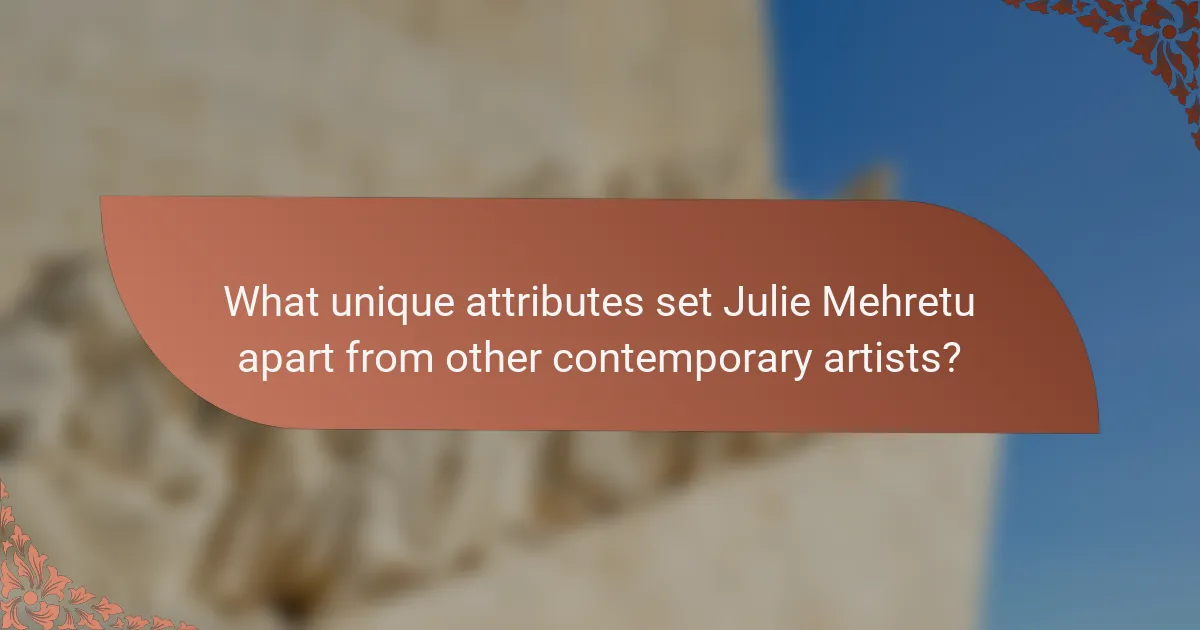
What unique attributes set Julie Mehretu apart from other contemporary artists?
Julie Mehretu’s unique attributes include her complex layering of narratives and abstract mapping techniques. Her work integrates diverse influences, allowing viewers to engage with visual language that reflects contemporary sociopolitical themes. The use of dynamic forms and spatial compositions distinguishes her from peers, offering a distinct perspective on abstraction. Additionally, her innovative approach to scale and materiality enhances the tactile experience of her art, setting her apart in the contemporary art landscape.
How does her background influence her artistic perspective?
Julie Mehretu’s background significantly shapes her artistic perspective by infusing her work with complex narratives and cultural references. Growing up in Ethiopia and later moving to the United States, she blends diverse influences from both environments. Her experiences are reflected in her use of abstract mapping, which captures the essence of urban landscapes and social dynamics. The unique attribute of her art lies in the layering of visual languages, creating a dialogue between history and contemporary issues. This multifaceted approach allows her to explore identity, migration, and memory, making her work resonate on multiple levels.
What rare techniques are evident in her most celebrated works?
Julie Mehretu employs rare techniques such as layering multiple narratives, integrating cartographic elements, and utilizing a dynamic visual language. These methods create complex, abstract compositions that reflect diverse cultural and historical contexts. Her unique approach to abstraction allows for a multifaceted interpretation of space and time, distinguishing her celebrated works in contemporary art.
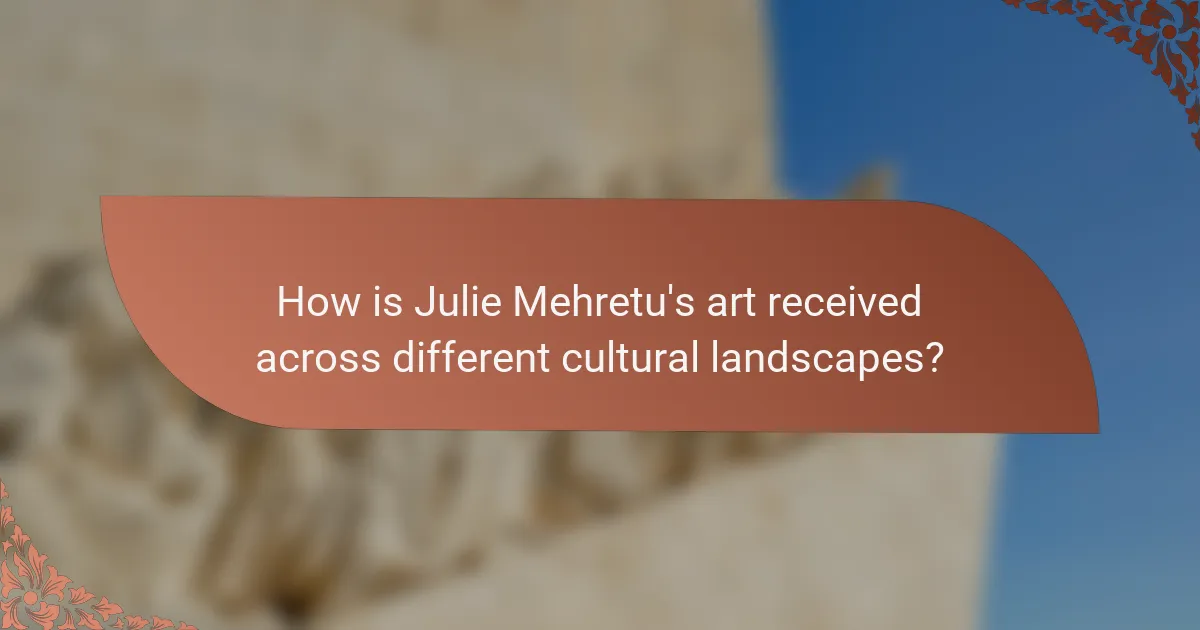
How is Julie Mehretu’s art received across different cultural landscapes?
Julie Mehretu’s art receives diverse interpretations across cultural landscapes, often reflecting local histories and social dynamics. Her abstract mapping techniques resonate with various audiences, as they invite viewers to engage with layered narratives. In Western contexts, her work is celebrated for its complex visual language and innovative approach to abstraction. Conversely, in non-Western settings, her art may be seen as a commentary on globalization and migration, emphasizing collective experiences. This duality highlights her unique ability to transcend cultural boundaries while maintaining a distinct artistic identity.
What are the common interpretations of her work in various regions?
Julie Mehretu’s work is interpreted differently across regions, reflecting local cultural contexts and historical narratives. In the United States, her abstract mapping often emphasizes themes of migration and urbanization, resonating with contemporary social issues. Conversely, in Europe, critics may focus on her visual language’s connection to historical cartography and colonialism, highlighting the layers of narrative in her pieces. In African regions, her work might be viewed through the lens of post-colonial identity, exploring connections to heritage and place. Each interpretation reveals unique attributes of her art, showcasing its global relevance and adaptability.
How do audience reactions differ based on cultural backgrounds?
Audience reactions to Julie Mehretu’s work vary significantly across cultural backgrounds. Cultural context influences interpretation, emotional response, and engagement with her abstract mapping and narrative layers. For instance, viewers from collectivist cultures may focus more on community narratives, while those from individualistic cultures might emphasize personal interpretation. Additionally, familiarity with abstract art can shape appreciation levels, with some cultures valuing representational clarity over abstraction. These differences highlight the impact of cultural frameworks on visual language interpretation.
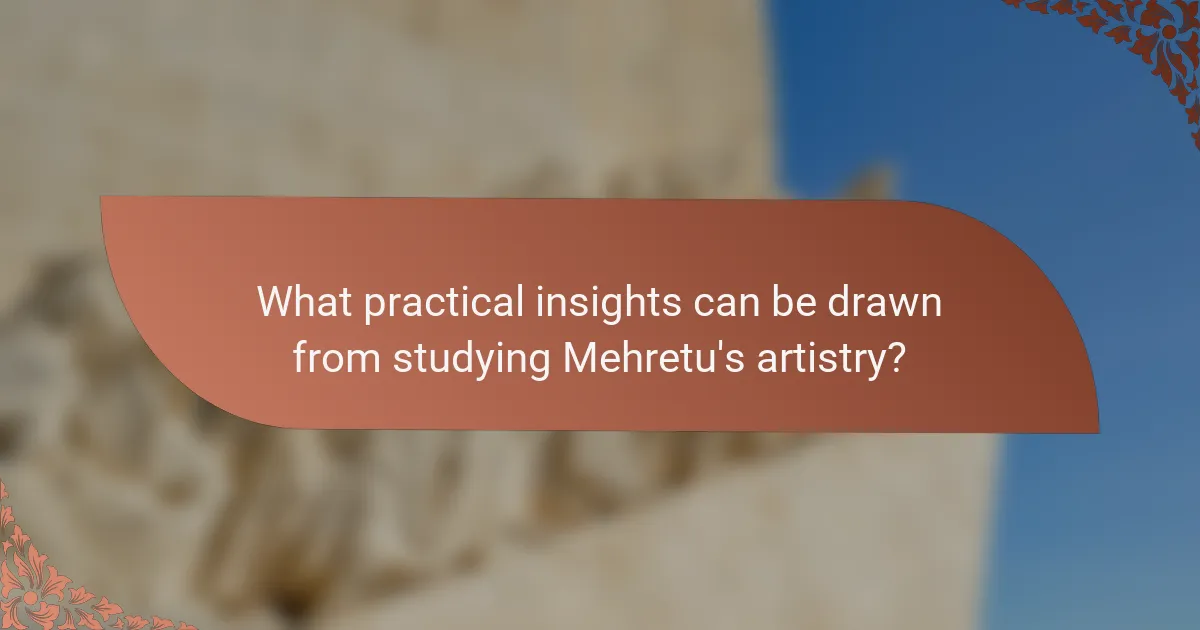
What practical insights can be drawn from studying Mehretu’s artistry?
Studying Julie Mehretu’s artistry reveals insights into the complexity of abstraction and narrative. Her work employs layers of meaning, encouraging viewers to engage with visual language in a multifaceted way.
Mehretu’s abstract mapping highlights the interplay between chaos and order, reflecting contemporary societal issues. This approach fosters a deeper understanding of spatial relationships and cultural narratives.
Additionally, her use of scale and texture enhances emotional resonance, inviting personal interpretation. The dynamic compositions challenge traditional boundaries, prompting discussions about identity and place.
Overall, Mehretu’s artistry serves as a powerful tool for exploring the intersections of history, geography, and personal experience.
What best practices can emerging artists learn from her techniques?
Emerging artists can learn several best practices from Julie Mehretu’s techniques. Her use of abstract mapping encourages artists to explore spatial relationships in their work. Incorporating narrative layers can add depth, allowing for multiple interpretations. Additionally, her unique visual language emphasizes the importance of personal expression and experimentation. These approaches foster creativity and can help artists develop a distinctive style.
Which common mistakes should be avoided when interpreting abstract art?
To interpret abstract art effectively, avoid over-analyzing and seeking explicit meaning. Focus on emotional response and visual elements instead. Common mistakes include imposing personal narratives, neglecting context, and overlooking the artist’s intention. Embrace ambiguity and allow for multiple interpretations.
